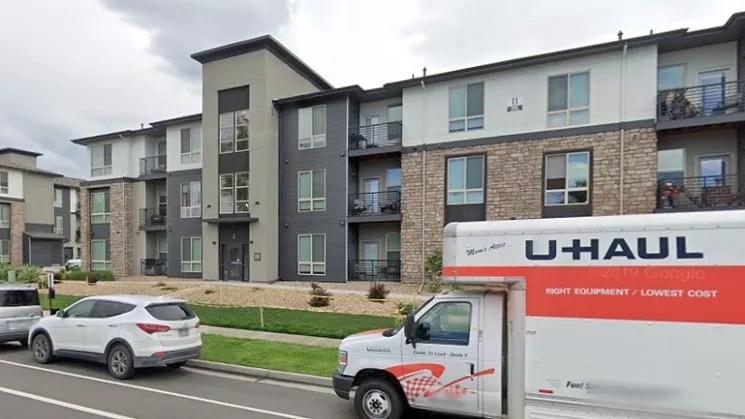
Google Maps

Audio By Carbonatix
Although rent prices in Denver have been rising again in recent months, a new national study reveals that the Mile High City and four other major Colorado communities were relative bargains compared to many other metro areas across the country during the first year of the COVID-19 pandemic.
Meanwhile, the Colorado Apartment Association says that the overwhelming majority of renters in the state are keeping up with their payments, even as the federal Centers for Disease Control and Prevention has extended its eviction moratorium to the end of July – although, the agency notes, “This is intended to be the final extension.”
The national rent report is from Stessa, which specializes in accounting tools for landlords of rental properties. Its authors drew from Zillow data over the period between March 2020 and March 2021 to track median rent changes in 105 American metropolitan statistical areas. Among them were five Colorado MSAs: Denver-Aurora-Lakewood, Boulder, Greeley, Fort Collins and Colorado Springs.
Nationally, Stessa points out, rent for single-family units jumped 5 percent over the March-to-March period, while lower-priced units ratcheted up 3.2 percent. Meanwhile, rent for standalone properties grew five times faster than costs for attached units.
Denver, make your New Year’s Resolution Count!
We’re $17,500 away from our End-of-Year campaign goal, with just a five days left! We’re ready to deliver — but we need the resources to do it right. If Westword matters to you, please contribute today to help us expand our current events coverage when it’s needed most.
In Denver, meanwhile, median rent went from $1,689 in March 2020 to $1,710 in March 2021 – a modest 1.2 percent increase, just below the national average rise of 1.3 percent. Many other cities had it worse: Boise, Idaho, saw the largest rent increase, with 13.1 percent.
The Colorado city with the largest rent increase was Colorado Springs, which landed in 24th place on the list of 105. The other four Colorado metro areas finished in the second half of the pack, with Denver in 93rd place. Granted, the Los Angeles MSA, which placed 98th, saw no rent increase at all during year one of COVID-19, and both San Francisco-Oakland-Berkeley and New York City-Newark-Jersey City saw declines of 8.3 percent and 8.5 percent, respectively. But the situation in and around the Mile High City certainly could have been worse.
Here are the specific numbers for the five Colorado metro areas:
24. Colorado Springs
Year-over-year change in rent: +7.3 percent
Median rent in March 2021: $1,611
Median rent in March 2020: $1,501
Overall cost of living (compared to U.S. average): -0.7 percent
Median income for renter households: $49,772
68. Greeley
Year-over-year change in rent: +4.3 percent
Median rent in March 2021: $1,736
Median rent in March 2020: $1,664
Overall cost of living (compared to U.S. average): -2.0 percent
Median income for renter households: $45,894
77. Boulder
Year-over-year change in rent: +3.8 percent
Median rent in March 2021: $2,013
Median rent in March 2020: $1,939
Overall cost of living (compared to U.S. average): +6.7 percent
Median income for renter households: $55,694
82. Fort Collins
Year-over-year change in rent: +3.1 percent
Median rent in March 2021: $1,549
Median rent in March 2020: $1,502
Overall cost of living (compared to U.S. average): +2.0 percent
Median income for renter households: $49,708
93. Denver-Aurora-Lakewood
Year-over-year change in rent: +1.2 percent
Median rent in March 2021: $1,710
Median rent in March 2020: $1,689
Overall cost of living (compared to U.S. average): +4.2 percent
Median income for renter households: $57,548
The Colorado Apartment Association’s figures reveal that rent collection for May 2021, the most recent month available, was at 97.9 percent. That’s 1.1 percent higher than in May 2020 and 0.9 percent above the national average. In the meantime, eviction filings in Colorado in May were around 25 percent of what they were two years earlier. In May 2019, Colorado registered 3,918 eviction filings, as compared to 808 in May 2021. Under CDC guidelines, renters who’ve faced COVID-related hardships have been protected from evictions, but evictions for other reasons have been allowed to continue.
CAA’s COVID-19 resources can be found at the “Rental Resources” tab on this page.